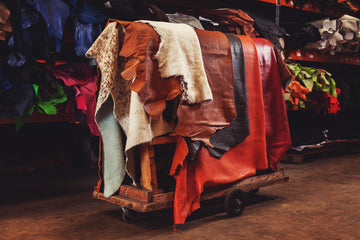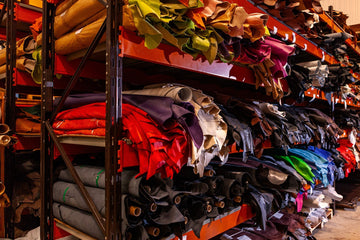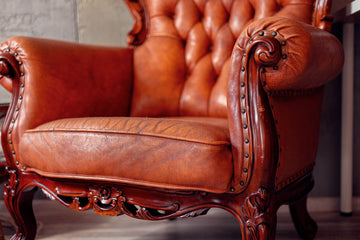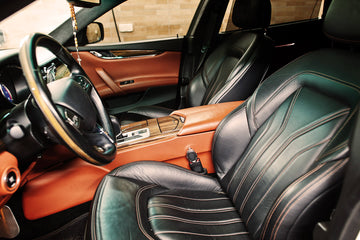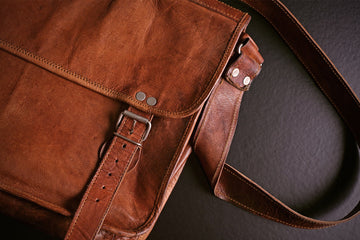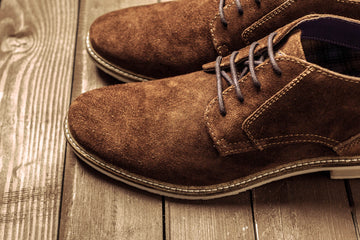Curious about what the main 5 types of leather are? This article will cover full-grain, top-grain, genuine, split-grain, and bonded leather, all of which are types of animal leather. You’ll learn about their unique qualities, durability, and best uses. Let’s dive right in.
Introduction to Leather
Leather is a versatile and durable material made from animal hides, such as cow, sheep, and goat leather. Several factors, including the grade, the type of hide, and the tanning process, determine its quality. Understanding these elements is crucial when selecting leather goods, as they directly impact the material’s durability, appearance, and overall performance.
Leather is a popular material used in a wide range of products, including fashion accessories, furniture, and clothing, due to its natural characteristics and exceptional durability. There are various types of leather, each with distinct characteristics and applications. These include full-grain leather, top-grain leather, genuine leather, split-grain leather, and bonded leather. Each type offers different benefits, making it essential to understand their differences to make informed purchasing decisions.
One of the most appealing aspects of leather is its natural breathability and ability to develop a rich patina over time. This characteristic makes it a popular choice for high-end fashion accessories and luxury bags, as it adds a unique, personalised touch to each item.
The tanning process, which involves treating the hide with chemicals or natural substances, plays a significant role in determining the quality and characteristics of the leather. Techniques such as embossing or creating suede finishes can enhance the leather’s appearance and durability.
Leather is a durable material that can last for decades with proper care and maintenance, making it a worthwhile investment for those who value quality and longevity. Its unique combination of style, durability, and versatility ensures that leather remains popular for various applications, from fashion and furniture to automotive and industrial uses.
Key Takeaways
- Full-grain leather is the highest quality and considered the best, valued for its exceptional durability, unique character, and natural beauty, making it an ideal choice for luxury items.
- Top-grain leather offers a polished finish and is more affordable than full-grain, providing suitable durability for everyday use.
- Genuine leather is a budget-friendly option that showcases versatile applications, despite its varied durability compared to higher-grade leathers.
Full-Grain Leather: The Pinnacle of Quality
Full-grain leather is considered the pinnacle of quality due to its exceptional durability and aesthetic appeal. Originating from the top layer of an animal's hide, full-grain leather showcases natural marks and textures that render each item distinctively individual. Unlike corrected grain or goat leathers, full-grain varieties maintain all aspects of the original grain, guaranteeing genuineness while preserving the hide’s innate features.
Renowned for its enduring nature, products crafted from full-grain leather are designed to stand the test of time, frequently outliving goods made with inferior types of leather. This robustness positions it as an optimal material for crafting upscale fashion accessories, elegant furniture pieces, and various luxury items where premium longevity is paramount.
The superior calibre associated with full-grain leather typically commands a higher price point than other grades within this material category. Nevertheless, many consumers value investing more upfront, considering its potential longevity. Every piece marked by distinctive blemishes and singular grain designs contributes to its visual charm and weaves a unique narrative into each article.
Choosing the full-grain type, despite being costlier, signifies valuing lasting excellence over short-term gains. This statement aligns well with those who prioritise ultimate-grade commodities in their collection. With advantages such as natural breathability and strength and the development of a refined patina through use over time, it speaks directly to connoisseurs desirous of premier-quality, durable goods crafted from authentic materials like the luscious grains found on these highly coveted hides.
Top-Grain Leather: A Polished Alternative
Buffing or sanding down the exterior layer of an animal hide results in the creation of top-grain leather, recognised as the second-best grade available. This method eliminates surface flaws, resulting in a softer and more even appearance than full-grain leather, while also potentially enhancing its quality through the careful selection and treatment of animal hides. The leather receives an artificial grain and finishing coat to improve its breathability and durability, making it suitable for luxury items like wallets and handbags.
Although it lacks some durability compared to full-grain leather due to its suppleness and flexibility, top-grain leather is nonetheless favoured for crafting high-end fashion accessories, such as luxury bags, shoes, and belts, owing to its refined finish that lends elegance alongside versatility.
The smoothness provided by the polished finish on top grain varieties contributes aesthetically and offers practical benefits, such as stain resistance and simpler upkeep—ideal qualities for everyday use items. Its inherent breathability curtails moisture retention, which amplifies comfort during wear. Thus making it an appealing choice for various types of leather goods.
Top grain encompasses both sophistication in looks and respectable longevity. Presenting itself as a harmonious mixture ideal for consumers seeking blended leathers that display both styles without significantly compromising endurance, this is a prime selection among various grades within high-quality leathers.
Genuine Leather: Affordable and Versatile
Corrected grain leather, also known as genuine leather, can be crafted from any layer of the hide and is recognised for its distinctive, naturally flawed grain pattern. Softer and more pliable than superior grades of leather, such as full-grain or top-grain, this type of leather presents a cost-effective alternative that remains accessible to a wide range of customers.
Although less expensive, corrected grain or genuine leather remains prevalent in many items. It’s routinely utilised for smaller personal goods such as wallets and belts, handbags, and even some lower-priced furniture pieces. These products undergo specific treatments to enhance their aesthetic qualities while retaining appeal across diverse uses.
The authenticity of genuine leather is characterised by innate features, such as its classic scent and textured grain surface, which set it apart from synthetic materials. When processed appropriately, it gains the advantageous property of water resistance, which is conducive to regular use scenarios, and prized durability factors that lend themselves well to long-term attraction.
Yet, despite these traits making natural leathers appealing, especially when considering maintenance, the endurance level seen in other high-grade varieties may not fully match that of corrected grains. As such, those interested in experiencing authentic leather ambience without engaging extensively in upkeep routines will find this category fittingly attractive.
Balancing economic practicality with quality aspects captures the appeal of merchandise made from genuine leather. While it may not compete equally with higher-tier options like top-grain, it capitalises on unique characteristics, making it a highly sought-after material across various product categories. Genuine leather offers a distinctive appearance and feel, making it an attractive option for consumers seeking budget-friendly choices without compromising aesthetics.
Split Grain Leather: Softness and Style
Derived from the lower layers of the hide, split grain leather is often used to make suede leather. This type of leather is known for its soft texture and flexibility, making it a popular choice for various applications, including clothing, accessories, and upholstery.
The soft texture of split grain leather is one of its most appealing features, but it requires special care to maintain its quality. It is essential to protect split grain leather from moisture to prevent damage, and special cleaning products are recommended for maintaining these items. Despite its need for careful maintenance, the flexibility of split-grain leather makes it suitable for various products.
An artificial second layer is often added to split leather for strength, but it is generally less durable than other types of leather. Split grain leather is composed of multiple layers, which are often painted to achieve a cohesive appearance. However, this processing can reduce breathability and durability compared to higher-quality leathers, such as full-grain or top-grain.
Split grain leather is particularly appreciated for its style and comfort. Whether used in fashion accessories or home décor, its softness and flexible material make it desirable for a wide range of products, including hide’s grain options.
Bonded Leather: Economical Option
Blended leather, crafted by combining shredded leather scraps with a bonding process that incorporates only 10-17% actual fibres from the original hide, is created by fusing these fragments and synthetic adhesives or latex. This yields a product with uniform looks due to its composite nature. Similarly constructed is reconstituted leather, which also employs comparable methods.
Its composition renders blended leather less resilient than other types, often leading to peeling or cracking over time. Despite this shortcoming, it finds widespread use in crafting affordable furniture items and fashion accessories such as couches and car upholstery. These end products typically receive a coating of synthetic materials designed to enhance their longevity.
Instead of exuding the organic scent distinctive to genuine leather, blended leather typically releases an odour indicative of chemicals, a potential deterrent for some buyers. Nevertheless, for those seeking more cost-effective options in leather offerings without a financial commitment to premium labels, enjoy what blended leather has to offer, despite its modest quality.
Offering fiscal relief in acquiring various goods made from animal hides, while compromising on the lasting power and authentic allure associated with superior grades like genuine leathers, the choice remains appealing among price-sensitive patrons who desire the look but not necessarily all the characteristics inherent in higher-end counterparts.
Understanding Leather Grades
The classification of leather grades is based on various aspects, including the quality and section of the hide, processing methodologies, finishing methods, and overall durability. Key factors determining leather quality include its grade, the type of hide material used, and the tanning process employed. Gaining insight into these elements is crucial for comparing leather grades and selecting the most suitable type of leather for specific applications.
Leather of higher quality levels undergoes less processing to preserve more natural characteristics present within the hide. In contrast, leathers considered lower-grade usually showcase a greater number of imperfections. Thus, they receive additional artificial treatments aimed at improving their visual appeal. This distinction plays a crucial role when evaluating different grades of leather against one another and making informed decisions about which type will best meet your project requirements.
Commonly known as corrected grain or top-grain leather, it undergoes refinement processes to eliminate blemishes on its surface, resulting in a uniform appearance. These modifications improve stain resistance properties while simplifying upkeep routines.
The routine care required by most leathers typically involves intermittent cleaning, coupled with conditioning using designated products crafted explicitly for treating them—this significantly aids in prolonging their service life. The selection process involving types should consider variables like specific usage criteria dictated by individual projects alongside cost constraints, without overlooking preferred visual outcomes.
When considering the acquisition of leathers, ensure that contemplation over the attributes intrinsic to certain varieties goes hand-in-hand with understanding the requisite maintenance strategies, followed by scrutinising price disparities between them, to ensure that choices made resonate efficiently with personal requirements and intended purposes.
The Tanning Process Explained
The production of leather hinges on the manufacturing process, which is primarily divided into two methods: chrome tanning and vegetable tanning. The use of toxic substances such as chromium and formaldehyde in chrome tanning poses serious health risks to those involved in its application. This method also generates substantial amounts of wastewater contaminated with chromium, posing environmental hazards.
In contrast, despite its popularity, only a minor fraction—approximately 10%—of total leather produced undergoes vegetable tanning. This more eco-friendly approach utilises natural elements, such as tree bark, leaves, and fruit, in the process. Vegetable-tanned leather emerges not only as an environmentally considerate choice, but also as a material superior in quality and sustainability.
Research has yet to establish significant ecological advantages between the two methods. Choosing one over the other profoundly impacts the quality and specific features inherent in the finished product.
Understanding how leather is processed can enhance appreciation for variances in both its calibre and associated ecological footprints. Selecting either sustainable practices or particular properties found within leathers becomes easier when informed about their respective production processes through knowledge acquisition regarding various aspects of their origins, be it from chemical-intensive chrome or naturally inclined vegetable methodologies during the craftsmanship stages, before purchase considerations made by potential buyers alike, depending upon personal preferences addressed accordingly, henceforth.
Characteristics of Nubuck Leather
Buffing or sanding down the outermost layer of cowhide or calfskin results in the creation of nubuck leather, which is characterised by its velvety soft surface. This type of leather boasts greater strength and thickness than suede, making it well-suited for various uses due to its durability.
Due to the intensive dying process required to conceal signs of its buffing technique, nubuck leather typically carries a higher price tag than suede does. This type of leather is often featured in products such as shoes, furniture, fashion accessories like belts and bags, garments, and upholstery items, despite being more expensive.
The plush texture that Nubuck possesses, akin to velvet, contributes significantly to its charm. It imparts an opulent touch wherever employed. Maintaining this exquisite feel involves vigilant care, though, since neglect can lead to loss of softness and increased vulnerability to stains.
In essence, products made with nubuck deliver a balanced mix of resilience and sumptuous comfort through their velvety finish, combined with robust performance traits sought after for premium-quality wares that offer both style and endurance over time.
Specialised Leather: Exploring Unique Varieties
Leather comes in many specialised varieties, each offering unique qualities and uses. Nubuck leather, for instance, is a type of top-grain leather that has been buffed or sanded on the grain side to create a soft, velvety texture and a more uniform appearance. This luxurious material is often used in high-end fashion accessories and furniture due to its elegant feel and durability.
Patent leather is another specialised type, known for its glossy, varnished finish that creates a shiny, reflective appearance. This coating enhances the leather’s durability and makes it a popular choice for fashion accessories and shoes that require a striking, polished look.
Exotic leather, made from the hides of non-traditional or rare animals such as alligators or ostriches, offers a luxurious and exclusive material used in high-end fashion accessories and luxury goods. These leathers are prized for their unique textures and patterns, making them a statement choice for those seeking something truly distinctive.
Vegetable-tanned leather is produced using natural materials, such as tree bark, resulting in a high-quality, sustainable material with a unique, natural appearance. This type of leather is known for its durability and ability to develop a rich patina over time, making it a favourite for those who appreciate eco-friendly products.
On the other hand, Chrome-tanned leather is tanned using chromium salts, resulting in a durable and versatile material with a more uniform appearance and enhanced resistance to wear and tear. This type of leather is commonly used in a wide range of products, from fashion accessories to automotive interiors.
Synthetic leather, also known as faux leather or vegan leather, mimics the appearance and texture of genuine leather but is made from synthetic materials. It offers a more affordable and environmentally friendly alternative to genuine leather, making it a popular choice for those on a budget or who prefer not to use animal products.
Bonded leather is made from shredded leather scraps and fibres, reconstituted into a new material. While it offers a more affordable option, it may lack the quality and durability of genuine leather. However, it remains a practical choice for budget-conscious consumers looking for leather-like products.
Corrected grain leather, or genuine leather, has been processed to remove imperfections and create a more uniform appearance. This type of leather is popular for fashion accessories and clothing, balancing quality and affordability.
Full-grain leather, considered the highest quality leather, is made from the entire hide and retains its natural grain and markings. This luxurious material is known for its exceptional durability and natural beauty, making it a top choice for high-end fashion accessories and luxury goods.
By exploring these unique varieties of leather, individuals can discover new and innovative ways to incorporate this versatile material into their lives, from fashion and furniture to automotive and industrial applications. Each type of leather offers distinct benefits, enabling a wide range of creative and practical applications.
How to Identify Real Leather
Numerous tactile assessments can determine the authenticity of leather. The distinct natural scent and grainy texture of genuine leather, derived from an animal's skin, set it apart from its synthetic counterparts. Real leather typically presents a soft, warm feel with a grainy exterior.
A straightforward approach to recognising real leather is through the water drop examination. When you place a droplet onto the surface and it is promptly absorbed, you deal with genuine leather. In contrast, water forms beads on synthetic materials without being absorbed.
Over time, authentic real leather acquires a rich patina that enhances its charm and attractiveness, becoming adept at distinguishing real from faux, which guarantees that your investments are in high-quality products made from true leather and genuine substances.
What is the Highest Grade of Leather?
The highest grade of leather is known as full-grain leather, which is celebrated for its unmatched quality and durability. This type of leather comes from the topmost layer of the animal’s hide, retaining all of its natural grain. Unlike other grades, full-grain leather is not sanded or buffed to remove imperfections, allowing it to showcase the hide’s natural markings and textures. This makes it a prime example of natural leather, known for its strength and longevity.
This preservation of the hide’s original characteristics contributes to the leather’s strength and longevity, making it the preferred choice for high-end fashion accessories, luxury bags, and premium furniture.
Full-grain leather’s reputation as the highest quality leather is further solidified by its ability to develop a rich patina over time. This patina enhances the leather’s aesthetic appeal and adds to its character, making each piece unique.
The natural breathability of full-grain leather ensures comfort during use, as it allows moisture to escape, preventing the buildup of sweat and odours. This quality makes it an ideal material for items that require both durability and comfort, such as shoes and upholstery.
Despite its premium status, full-grain leather requires proper care to maintain its appearance and longevity. Regular conditioning with leather-specific products helps preserve its natural oils and prevents drying or cracking.
While it commands a higher price point than other leather types, many consumers consider the investment worthwhile due to its exceptional durability and timeless elegance. Choosing full-grain leather signifies a preference for superior quality and a commitment to owning functional and aesthetically pleasing products over the long term.
How to Tell if Leather is Good Quality
Determining the quality of leather involves assessing several key characteristics that distinguish high-quality leather from inferior types. One of the most reliable indicators is the leather’s grain. Full-grain leather, which retains the entire grain layer of the animal’s hide, is often considered the highest quality due to its durability and natural appearance.
Natural markings and textures, such as scars or wrinkles, suggest that the leather is genuine and has not been overly processed. These imperfections add character and uniqueness to the leather, enhancing its appeal.
Another crucial factor in assessing leather quality is its texture and feel. High-quality leather should feel supple and smooth, with a rich, warm texture that is neither too stiff nor overly soft. The leather should also exhibit a consistent colour throughout, indicating that it has been dyed thoroughly rather than surface-painted. Additionally, understanding different types of leather finishes is essential, as these finishes impact the final products' functionality, cost efficiency, and desirability. Leather finishes can range from aniline to semi-aniline and pigmented, each providing distinct appearances and characteristics.
Authentic leather typically has a distinctive, earthy scent absent in synthetic or lower-grade leathers. This natural aroma is a telltale sign of genuine leather and can help differentiate it from faux leather options.
Ultimately, the craftsmanship and construction of leather goods can offer valuable insights into the leather quality used. Examine the stitching and seams of the product; high-quality leather items will have even, tight stitching that indicates careful craftsmanship. The edges of the leather should be smooth and well-finished, without fraying or roughness.
Furthermore, high-quality leather products often develop a rich patina over time, enhancing their aesthetic appeal and indicating their longevity. Paying attention to these details will help ensure that you are investing in leather goods that are both durable and visually appealing.
Why Buy Leather Online from Rolford Leather
Boasting over half a century of expertise, Rolford Leather is committed to delivering only the highest quality when it comes to leather materials. Our proficiency has been honed through working closely with leading tanneries in the industry, and this experience forms the bedrock of our exceptional product selection. The aim at Rolford Leather is clear: we endeavour to supply top-tier leathers within the UK and globally.
Our extensive inventory encompasses various leather hides and skins suitable for various purposes. We cater to those crafting leather goods and individuals seeking high-quality leather for personal endeavours or hobbies. At Rolford Leather, customer satisfaction remains paramount—we gladly offer guidance and help fulfil any specific needs you might have, while maintaining an unwavering commitment to excellence across our products, which blend age-old methods with contemporary innovation.
The origin of our leathers is nothing short of premium quality tanneries worldwide, which allows us to guarantee consistency and reliability from our Northamptonshire warehouse stocks. Every item within our vast selection—from whole hides to individual animal skins—is carefully chosen so your projects can reach their fullest potential in terms of beauty and craftsmanship. Among our premium options, we proudly offer Napa leather, known for its supple and graceful texture, making it an ideal choice for handbags and wallets.
We stand behind those who breathe life into unique designs—whether entrepreneurs involved in leathercrafting, aspiring students, or inventive designers—and encourage exploration by offering complimentary sample swatches, so customers can make informed choices before purchasing. For added convenience, no minimum purchase requirements exist for items available immediately from stock.
Clients may opt for just one skin or hide if desired. Should more substantial quantities be necessary, we provide immediate access via stockpile or direct sourcing from affiliated tanneries and exhaustive inspection services upon request.
Need expert advice? Contact us for guidance on selecting the ideal leather for your project.
Summary
Grasping the distinctions between various leather types, such as Full Grain, Top Grain, Genuine, Split Grain, and Bonded, is crucial for appreciating their features, uses, and levels of quality. Full-grain leather is renowned for its longevity and authentic texture. Top grain leather offers an elegant yet functional alternative. Genuine leather strikes a balance between cost-effectiveness and adaptability. Split grain brings softness paired with fashionability. Those on a tighter budget seeking widespread utility in products can find solace in bonded leather.
Acknowledging these variances enables you to select products made from this material more intelligently, matching them to your desired aesthetic appeal and resilience mix. No matter what drives your purchase—be it exemplary craftsmanship or monetary considerations—the insight into these differing kinds of leathers will steer you towards the most suitable option that fulfils your particular requirements.
